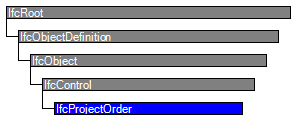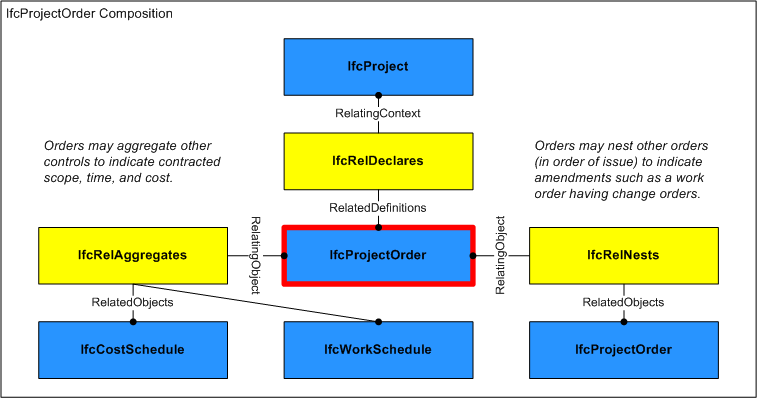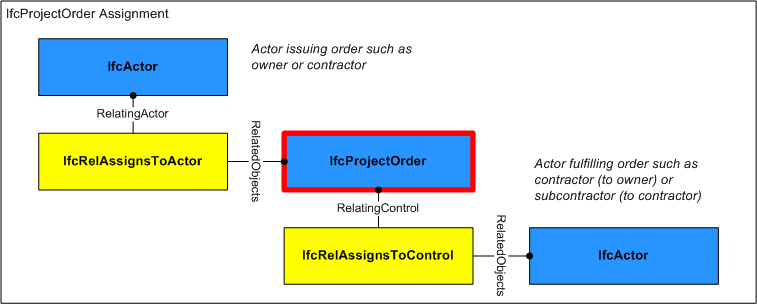Natural language names
 | Projektanweisung |
 | Project Order |
Change log
| Item | SPF | XML | Change | Description | IFC2x3 to IFC4 4.0.0.0 |
|---|---|---|---|---|
| IfcProjectOrder | ||||
| OwnerHistory | MODIFIED | Instantiation changed to OPTIONAL. | ||
| Identification | X | MODIFIED | Name changed from ID to Identification. Instantiation changed to OPTIONAL. | |
| PredefinedType | MODIFIED | Instantiation changed to OPTIONAL. | ||
| LongDescription | ADDED |
Semantic definitions at the entity
Entity definition
A project order is a directive to purchase products and/or perform work, such as for construction or facilities management.
Project orders are typically formal contracts between two organizations, where cost and time information may be rigid or flexible according to contained schedule types and constraints.
HISTORY New entity in IFC2.0
IFC4 CHANGE Attribute ID renamed to Identification and promoted to supertype IfcControl. Attribute 'LongDescription' added.
Attribute definitions
| # | Attribute | Type | Cardinality | Description | G |
|---|---|---|---|---|---|
| 7 | PredefinedType | IfcProjectOrderTypeEnum | ? |
Predefined generic type for a project order that is specified in an enumeration. There may be a property set given specificly for the predefined types.
IFC4 CHANGE The attribute has been made optional. | X |
| 8 | Status | IfcLabel | ? |
The current status of a project order.Examples of status values that might be used for a project order status include:
| X |
| 9 | LongDescription | IfcText | ? | A detailed description of the project order describing the work to be completed. | X |
Inherited definitions from supertypes
Entity inheritance

Attribute inheritance
| # | Attribute | Type | Cardinality | Description | G |
|---|---|---|---|---|---|
| IfcRoot | |||||
| 1 | GlobalId | IfcGloballyUniqueId | Assignment of a globally unique identifier within the entire software world. | X | |
| 2 | OwnerHistory | IfcOwnerHistory | ? |
Assignment of the information about the current ownership of that object, including owning actor, application, local identification and information captured about the recent changes of the object,
NOTE only the last modification in stored - either as addition, deletion or modification. IFC4 CHANGE The attribute has been changed to be OPTIONAL. | X |
| 3 | Name | IfcLabel | ? | Optional name for use by the participating software systems or users. For some subtypes of IfcRoot the insertion of the Name attribute may be required. This would be enforced by a where rule. | X |
| 4 | Description | IfcText | ? | Optional description, provided for exchanging informative comments. | X |
| IfcObjectDefinition | |||||
| HasAssignments | IfcRelAssigns @RelatedObjects | S[0:?] | Reference to the relationship objects, that assign (by an association relationship) other subtypes of IfcObject to this object instance. Examples are the association to products, processes, controls, resources or groups. | X | |
| Nests | IfcRelNests @RelatedObjects | S[0:1] | References to the decomposition relationship being a nesting. It determines that this object definition is a part within an ordered whole/part decomposition relationship. An object occurrence or type can only be part of a single decomposition (to allow hierarchical strutures only).
IFC4 CHANGE The inverse attribute datatype has been added and separated from Decomposes defined at IfcObjectDefinition. | X | |
| IsNestedBy | IfcRelNests @RelatingObject | S[0:?] | References to the decomposition relationship being a nesting. It determines that this object definition is the whole within an ordered whole/part decomposition relationship. An object or object type can be nested by several other objects (occurrences or types).
IFC4 CHANGE The inverse attribute datatype has been added and separated from IsDecomposedBy defined at IfcObjectDefinition. | X | |
| HasContext | IfcRelDeclares @RelatedDefinitions | S[0:1] | References to the context providing context information such as project unit or representation context. It should only be asserted for the uppermost non-spatial object.
IFC4 CHANGE The inverse attribute datatype has been added. | X | |
| IsDecomposedBy | IfcRelAggregates @RelatingObject | S[0:?] | References to the decomposition relationship being an aggregation. It determines that this object definition is whole within an unordered whole/part decomposition relationship. An object definitions can be aggregated by several other objects (occurrences or parts).
IFC4 CHANGE The inverse attribute datatype has been changed from the supertype IfcRelDecomposes to subtype IfcRelAggregates. | X | |
| Decomposes | IfcRelAggregates @RelatedObjects | S[0:1] | References to the decomposition relationship being an aggregation. It determines that this object definition is a part within an unordered whole/part decomposition relationship. An object definitions can only be part of a single decomposition (to allow hierarchical strutures only).
IFC4 CHANGE The inverse attribute datatype has been changed from the supertype IfcRelDecomposes to subtype IfcRelAggregates. | X | |
| HasAssociations | IfcRelAssociates @RelatedObjects | S[0:?] | Reference to the relationship objects, that associates external references or other resource definitions to the object.. Examples are the association to library, documentation or classification. | X | |
| IfcObject | |||||
| 5 | ObjectType | IfcLabel | ? | The type denotes a particular type that indicates the object further. The use has to be established at the level of instantiable subtypes. In particular it holds the user defined type, if the enumeration of the attribute PredefinedType is set to USERDEFINED. | X |
| IsDeclaredBy | IfcRelDefinesByObject @RelatedObjects | S[0:1] | Link to the relationship object pointing to the declaring object that provides the object definitions for this object occurrence. The declaring object has to be part of an object type decomposition. The associated IfcObject, or its subtypes, contains the specific information (as part of a type, or style, definition), that is common to all reflected instances of the declaring IfcObject, or its subtypes.
IFC4 CHANGE New inverse relationship, change made with upward compatibility for file based exchange. | X | |
| Declares | IfcRelDefinesByObject @RelatingObject | S[0:?] | Link to the relationship object pointing to the reflected object(s) that receives the object definitions. The reflected object has to be part of an object occurrence decomposition. The associated IfcObject, or its subtypes, provides the specific information (as part of a type, or style, definition), that is common to all reflected instances of the declaring IfcObject, or its subtypes.
IFC4 CHANGE New inverse relationship, change made with upward compatibility for file based exchange. | X | |
| IsTypedBy | IfcRelDefinesByType @RelatedObjects | S[0:1] | Set of relationships to the object type that provides the type definitions for this object occurrence. The then associated IfcTypeObject, or its subtypes, contains the specific information (or type, or style), that is common to all instances of IfcObject, or its subtypes, referring to the same type.
IFC4 CHANGE New inverse relationship, the link to IfcRelDefinesByType had previously be included in the inverse relationship IfcRelDefines. Change made with upward compatibility for file based exchange. | X | |
| IsDefinedBy | IfcRelDefinesByProperties @RelatedObjects | S[0:?] | Set of relationships to property set definitions attached to this object. Those statically or dynamically defined properties contain alphanumeric information content that further defines the object.
IFC4 CHANGE The data type has been changed from IfcRelDefines to IfcRelDefinesByProperties with upward compatibility for file based exchange. | X | |
| IfcControl | |||||
| 6 | Identification | IfcIdentifier | ? |
An identifying designation given to a control
It is the identifier at the occurrence level.
IFC4 CHANGE Attribute unified by promoting from various subtypes of IfcControl. | X |
| Controls | IfcRelAssignsToControl @RelatingControl | S[0:?] | Reference to the relationship that associates the control to the object(s) being controlled. | X | |
| IfcProjectOrder | |||||
| 7 | PredefinedType | IfcProjectOrderTypeEnum | ? |
Predefined generic type for a project order that is specified in an enumeration. There may be a property set given specificly for the predefined types.
IFC4 CHANGE The attribute has been made optional. | X |
| 8 | Status | IfcLabel | ? |
The current status of a project order.Examples of status values that might be used for a project order status include:
| X |
| 9 | LongDescription | IfcText | ? | A detailed description of the project order describing the work to be completed. | X |
Definitions applying to General Usage
IfcProjectOrder
Concept usage
Approval
The Approval Association concept applies to this entity.
Approvals may be associated to indicate the status of acceptance or rejection using the IfcRelAssociatesApproval relationship where RelatingApproval refers to an IfcApproval and RelatedObjects contains the IfcProjectOrder. Approvals may be split into sub-approvals using IfcApprovalRelationship to track approval status separately for each party where RelatingApproval refers to the higher-level approval and RelatedApprovals contains one or more lower-level approvals. The hierarchy of approvals implies sequencing such that a higher-level approval is not executed until all of its lower-level approvals have been accepted.
Property Sets for Objects
The Property Sets for Objects concept template applies to this entity as shown in Table 329.
| ||||||||||||||||||
Table 329 — IfcProjectOrder Property Sets for Objects |
Aggregation
The Aggregation concept template applies to this entity as shown in Table 330.
Table 330 — IfcProjectOrder Aggregation |
As shown in Figure 160, an IfcProjectOrder may be aggregated into components.
 |
Figure 411 — Project order composition |
Nesting
The Object Nesting concept template applies to this entity as shown in Table 331.
| ||||
Table 331 — IfcProjectOrder Object Nesting |
Control Assignment
The Control Assignment concept applies to this entity.
Figure 412 illustrates IfcProjectOrder assignment relationships as indicated:
- IfcActor (IfcRelAssignsToActor): Organization issuing the order such as an owner or contractor.
The IfcProjectOrder may have assignments of its own using the IfcRelAssignsToControl relationship where RelatingControl refers to the IfcProjectOrder and RelatedObjects contains one or more objects of the following types:
- IfcActor: Organization(s) contracted to fulfill the order, typically a single contractor, subcontractor, or supplier.
 |
Figure 412 — Project order assignment |
mvdXML Specification
<?xml version="1.0" encoding="utf-8"?>
<ConceptRoot xmlns:xsi="http://www.w3.org/2001/XMLSchema-instance" uuid="3ee15b73-6ba1-43cd-ae35-4a992bff7194" name="IfcProjectOrder" applicableRootEntity="IfcProjectOrder">
<Applicability>
<Template ref="4a930b17-bb1e-498c-ac7a-2ec6e6c2112d" />
<TemplateRules operator="and">
</TemplateRules>
</Applicability>
<Concepts>
<Concept uuid="3204db32-bcf5-4e61-8780-ee13e7fdb867" name="Approval">
<Template ref="52561fda-4281-409d-aa07-da485302249e" />
</Concept>
<Concept uuid="0159cb88-1d41-43bb-a97c-7d44a9864b7b" name="Property Sets for Objects">
<Template ref="f74255a6-0c0e-4f31-84ad-24981db62461" />
<TemplateRules operator="and">
<TemplateRule Parameters="PredefinedType[Value]='CHANGEORDER' AND PsetName[Value]='Pset_ProjectOrderChangeOrder'" />
<TemplateRule Parameters="PredefinedType[Value]='MAINTENANCEWORKORDER' AND PsetName[Value]='Pset_ProjectOrderMaintenanceWorkOrder'" />
<TemplateRule Parameters="PredefinedType[Value]='MOVEORDER' AND PsetName[Value]='Pset_ProjectOrderMoveOrder'" />
<TemplateRule Parameters="PredefinedType[Value]='PURCHASEORDER' AND PsetName[Value]='Pset_ProjectOrderPurchaseOrder'" />
<TemplateRule Parameters="PredefinedType[Value]='WORKORDER' AND PsetName[Value]='Pset_ProjectOrderWorkOrder'" />
</TemplateRules>
</Concept>
<Concept uuid="08aa2052-935a-4c54-82ee-7481bc903a0a" name="Aggregation">
<Template ref="02eefcc6-b26c-4f20-9c7c-c30ae74eb9a9" />
<TemplateRules operator="and">
<TemplateRule Description="A cost schedule may indicate costs and quantities where the cost schedule type may designate whether rates and/or quantities are estimated or final. Such cost schedule may have assigned cost items indicating detail, where each cost item may have assigned products, processes, or resources." />
<TemplateRule Description="A work schedule may indicate tasks and scheduled times where the work schedule type may designate whether tasks and/or times are planned or actual. Such work schedule may have assigned tasks indicating detail, where tasks may be assigned to products and may have assigned resources." />
</TemplateRules>
</Concept>
<Concept uuid="61019e9f-8b19-4990-a319-a1c7eea74da7" name="Nesting">
<Template ref="38ca8788-5e47-411c-8294-d56f9e9a5691" />
<TemplateRules operator="and">
<TemplateRule Description="May contain subordinate orders, particularly change orders indicating contract amendment in order of issue." Parameters="Type[Type]='IfcProjectOrder'" />
</TemplateRules>
</Concept>
<Concept uuid="120f33f1-252d-4a71-a561-d1e2ce601c39" name="Control Assignment">
<Template ref="813e73fe-5641-4648-a680-8887cf4359f1" />
</Concept>
</Concepts>
</ConceptRoot>
Concept inheritance
| # | Concept | Template | Model View |
|---|---|---|---|
| IfcRoot | |||
| Identity | Software Identity | General Usage | |
| Revision Control | Revision Control | General Usage | |
| IfcObjectDefinition | |||
| Classification Association | Classification Association | General Usage | |
| Assignment to Product | Assignment to Product | General Usage | |
| IfcObject | |||
| Object User Identity | Object User Identity | General Usage | |
| Object Predefined Type | Object Predefined Type | General Usage | |
| Object Typing | Object Typing | General Usage | |
| Property Sets with Override | Property Sets with Override | General Usage | |
| IfcProjectOrder | |||
| Approval | Approval Association | General Usage | |
| Property Sets for Objects | Property Sets for Objects | General Usage | |
| Aggregation | Aggregation | General Usage | |
| Nesting | Object Nesting | General Usage | |
| Control Assignment | Control Assignment | General Usage | |
Formal representations
XML Specification
<xs:element name="IfcProjectOrder" type="ifc:IfcProjectOrder" substitutionGroup="ifc:IfcControl" nillable="true"/>
<xs:complexType name="IfcProjectOrder">
<xs:complexContent>
<xs:extension base="ifc:IfcControl">
<xs:attribute name="PredefinedType" type="ifc:IfcProjectOrderTypeEnum" use="optional"/>
<xs:attribute name="Status" type="ifc:IfcLabel" use="optional"/>
<xs:attribute name="LongDescription" type="ifc:IfcText" use="optional"/>
</xs:extension>
</xs:complexContent>
</xs:complexType>
EXPRESS Specification
ENTITY IfcProjectOrder
SUBTYPE OF (IfcControl);
PredefinedType : OPTIONAL IfcProjectOrderTypeEnum;
Status : OPTIONAL IfcLabel;
LongDescription : OPTIONAL IfcText;
END_ENTITY;

 Instance diagram
Instance diagram Link to this page
Link to this page